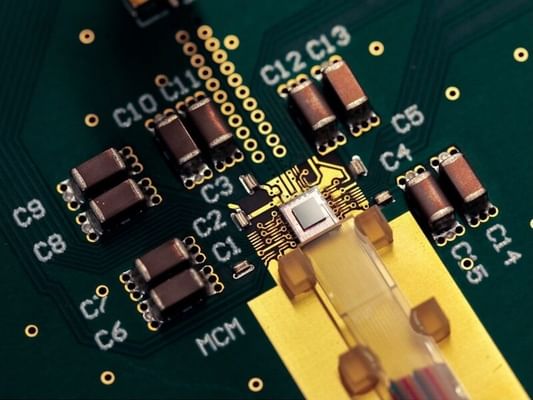- Undergraduate
Bachelor's Degrees
Bachelor of ArtsBachelor of EngineeringDual-Degree ProgramUndergraduate AdmissionsUndergraduate Experience
- Graduate
Graduate Experience
- Research
- Entrepreneurship
- Community
- About
-
Search
All Thayer News

New Study Addresses Critical Challenges in AI Bandwidth and Energy Efficiency
Mar 26, 2025
Artificial intelligence (AI) systems promise transformative advancements, yet their growth has been limited by energy inefficiencies and bottlenecks in data transfer. A multi-institutional team from Dartmouth, Columbia, and Cornell has developed a 3D photonic-electronic platform that paves the way for next-generation AI hardware.

Image of the heterogeneously-integrated electronic-photonic multi-chip module. (Photo courtesy of Lightwave Research Laboratory, Columbia University)
The study, "Three-dimensional photonic integration for ultra-low-energy, high-bandwidth interchip data links," published in Nature Photonics, details a pioneering method that integrates photonics with advanced complementary-metal-oxide-semiconductor (CMOS) electronics to redefine energy-efficient, high-bandwidth data communication. This innovation addresses critical challenges in data movement, a persistent obstacle to realizing faster and more efficient AI technologies.
"Our work combines two semiconductor chips—one that processes light and one that processes electricity—to transmit enormous amounts of data between computer chips with unprecedented energy efficiency," says Dartmouth Engineering Professor Anthony Rizzo, a lead author on the study. "These results have the potential to dramatically reduce the energy consumption of data centers while simultaneously increasing their computational performance for important AI workloads."
This innovative platform enables AI systems to efficiently transfer vast volumes of data, supporting distributed architectures that were previously impractical due to energy and latency limitations.
Designed for low cost, the chip integrates photonic devices with CMOS electronic circuits and leverages components manufactured in commercial foundries, setting the stage for widespread industry adoption.
The resulting advancements are poised to unlock unprecedented levels of performance, making this technology a cornerstone of future computing systems across applications, from large-scale AI models to real-time data processing in autonomous systems. Beyond AI, this approach holds transformative potential for high-performance computing, telecommunications, and disaggregated memory systems, signaling a new era of energy-efficient, high-speed computing infrastructure.
This project was funded by the Defense Advanced Research Projects Agency (DARPA) and the Advanced Research Projects Agency-Energy (ARPA-E).
Link to source:
For contacts and other media information visit our Media Resources page.
